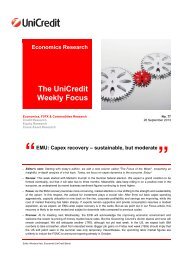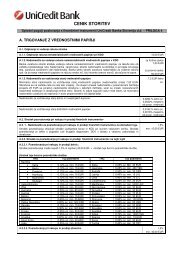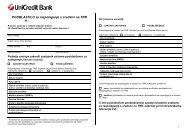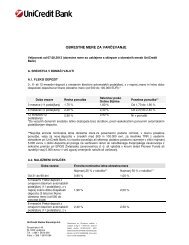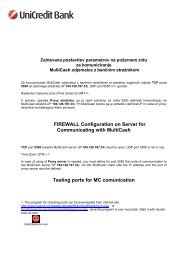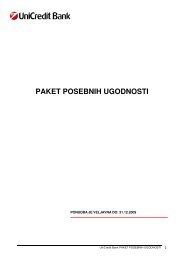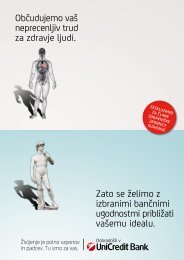Letno poroÄilo 2009.pdf - UniCredit Banka Slovenija dd
Letno poroÄilo 2009.pdf - UniCredit Banka Slovenija dd
Letno poroÄilo 2009.pdf - UniCredit Banka Slovenija dd
- No tags were found...
You also want an ePaper? Increase the reach of your titles
YUMPU automatically turns print PDFs into web optimized ePapers that Google loves.
FOREIGN CURRENCY TRANSLATIONFunctional and presentation currency: Items included in the financialstatements for both years, 2009 and 2008, are measured in euros,which is the Bank’s functional and presentation currency.Transactions and balances: Foreign currency transactions aretranslated into the functional currency using the European CentralBank exchange rates at the dates of transactions. Foreign exchangegains and losses resulting from the settlement of such transactionsand from the translation at year-end exchange rates of monetaryassets and liabilities denominated in foreign currencies arerecognized in the income statement except when deferred in equityas qualifying cash flow hedges and available-for-sale investments.Forward transactions denominated in a foreign currency are translatedinto euro using the forward rate.The spot rates of exchange used in preparation of the Bank’sbalance sheet as of the reporting date were as follows:Currency 31. 12. 2009 31. 12. 2008CHF 1.4836 1.4098USD 1.4406 1.4963Financial assetsThe Bank classifies its financial assets into the following categories:financial assets at fair value through profit or loss, loans andreceivables, held-to-maturity investments, and available-for-salefinancial assets. The Bank determines the classification of itsinvestments at initial recognition.All financial assets held by the Bank are recognized and derecognizedusing trade date accounting except loans and receivables, which arerecognized on settlement date. When a financial asset is recognizedinitially, the Bank measures it at its fair value plus, in the case of afinancial asset not-at-fair-value through profit or loss, transactioncosts that are directly attributable to the acquisition of the financialasset.The Bank derecognizes a financial asset when the contractualrights to the cash flows from the asset expire, or it transfers therights to receive the contractual cash flows on the financial assetin a transaction in which substantially all the risks and rewardsof ownership of the financial asset are transferred. Any interest intransferred financial assets that is created or retained by the Bank isrecognized as a separate asset or liability.The Bank derecognizes a financial liability when its contractualobligations are discharged or cancelled or expire.(a) Financial Assets at Fair Value through Profit or LossThis category contains financial assets held for trading and thosewhich are upon initial recognition designated by the Bank as at fairvalue through profit or loss.• A financial asset is classified as held for trading if it is acquiredor incurred principally for the purpose of selling or repurchasingin the near term or if it is a part of portfolio of identified financialinstruments that are managed together and for which there isevidence of a recent actual pattern of short-term profit-taking.Derivatives are also categorized as held for trading unless they aredesignated as hedging instruments.Subsequent to the initial recognition, these financial assets areaccounted for and stated at their fair value, which approximatesthe price quoted on recognized stock exchanges or calculated byacceptable valuation models. The fair value model separates theinterest rate risk and the credit spread for a particular security. Thecredit spread gets updated regularly according to the benchmarkand frequency agreed for the single name.The Bank includes unrealized gains and losses in ”Gains andlosses on financial assets and liabilities held for trading”. Interestearned on trading securities is accrued on a daily basis andreported in “Interest Income” in the Income Statement.• The Bank’s financial assets are designated at fair value throughprofit or loss when doing so significantly reduces measurementinconsistencies that would arise if the related derivatives weretreated as held for trading and the underlying financial instrumentswere measured at effective interest method.Loans measured at fair value through profit or loss are fixed-rateloans which are hedged at the loans' reference rate with interestrate swaps. Loans are designated at their fair value through profitor loss in order to avoid a mismatch in the presentation of theeconomic content of a transaction. The change in fair value ofloans is based on a marked to model methodology on a monthlybasis.(b) Loans and ReceivablesLoans and receivables are non-derivative financial assets with fixed ordeterminable payments that are not quoted in an active market, otherthan:• Those that the Bank intends to sell immediately or in the short• term, which are classified as held for trading, and those that theBank upon initial recognition designates as at fair value throughprofit or loss;• Those that the Bank upon initial recognition designates asavailable-for-sale; or• Those for which the holder may not recover substantially all of itsinitial investment, other than because of credit deterioration.The Bank assesses at each reporting date whether there is anyindication that an asset may be impaired. If any such indication<strong>UniCredit</strong> Bank · 2009 Annual Report 175



